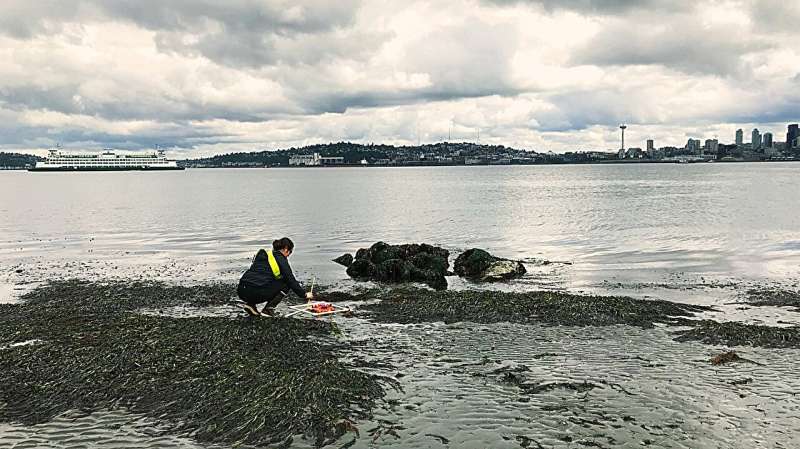
An international team of researchers discovered that coastal urban seagrass ecosystems can significantly reduce human bacterial pathogens, including those with widespread antibiotic resistance, in marine bivalves—a vital food source for people around the world.
The study, published Aug 2 in the journal Nature Sustainability, sheds light on the significant role seagrass meadows play in their ecosystems. Not only do they serve as crucial habitats for marine life and contribute to biodiversity and clearer waters, but they also act as natural filtration systems, reducing bacterial pathogens in the surrounding waters.
This is important because the current economic burden of human infectious diseases in marine environments is estimated at $12 billion annually. Furthermore, the looming threat of antimicrobial resistance, projected to cause over 300 million deaths and cost the global economy $100 trillion, underscores the urgency of such natural interventions.
“Our paper presents the first evidence that coastal urban seagrass ecosystems can reduce human bacterial pathogens, several with known widespread antibiotic resistance, in a food source that has the potential to support over half of global seafood production and consumption,” said Joleah Lamb, assistant professor at the University of California, Irvine, Charlie Dunlop School of Biological Sciences, who led the research with Drew Harvell, professor emerita of ecology and evolutionary biology at Cornell.
The team analyzed mussels deployed by Washington’s Department of Fish and Wildlife Mussel Watch across 20 Puget Sound beaches with varying seagrass presence. Mussel gills from locations with seagrass showed a 65% reduction in bacterial pathogens compared with those from places without seagrass.
This study adds to Lamb and Harvell’s previous work showing 50% reductions in pathogenic bacteria in Indonesia seagrass meadows, and suggests that intact seagrass ecosystems in both tropical and temperate waters could play a vital role in ensuring safer seafood and enhancing public health.
“Seagrasses have untapped potential to contribute to the chain of survival for humans and our coastal biodiversity,” Harvell said. “Seagrass meadows are prime feeding grounds for wild birds and shelter crabs, oysters, mussels and sea stars, and so the role of lower bacteria has yet unmeasured benefit for wildlife as well as humans.”
Harvell’s Cornell research team of postdocs, graduate students and undergraduates has been studying the health of seagrass and drivers of decline in the San Juan Islands and Friday Harbor Labs for over a decade. The Cornell-based research team for this project included not only Lamb, but also Phoebe Dawkins, then a graduate student in Harvell’s lab, and undergraduate Evan Fiorenza ’17.
The potential applications of this research are vast, Lamb said. As global food demand accelerates, securing safe and sustainable seafood from a healthy ocean is critical. Seagrass meadows, which are already recognized for their high-value services such as nutrient cycling, carbon sequestration and shoreline protection, now present an added layer of public health benefits.
The study’s model estimates that 1.1 billion people currently live within 50 kilometers of seagrass ecosystems, highlighting the immediate opportunity to integrate these natural infrastructures into urban planning and conservation strategies.
This research aligns with numerous global sustainability initiatives, including the U.N. Decade of Ocean Science for Sustainable Development and the U.N. Decade on Ecosystem Restoration. It provides timely evidence to inform policies and commitments aimed at reversing the decline of seagrass ecosystems, which are disappearing at an alarming rate of 7% per year.
The study’s implications extend beyond immediate public health benefits, Lamb said, offering a blueprint for sustainable urban development that leverages nature’s powers to address global challenges.
Lamb has called for a concerted effort from policymakers, urban planners and conservationists to recognize and harness the benefits of seagrass ecosystems.
“As ecosystems continue to decline globally, there is an urgent need to invest in environmental conservation and assess the value of ecosystem services,” she said. “By doing so, we can make significant strides in addressing the biodiversity and climate crises while simultaneously improving human health and food security.”
This research was supported by the Sea Doc Society, a program of the Karen C. Drayer Wildlife Health Center at the School of Veterinary Medicine at the University of California, Davis; the University of California, Irvine; and The Nature Conservancy.
More information:
Phoebe D. Dawkins et al, Seagrass ecosystems as green urban infrastructure to mediate human pathogens in seafood, Nature Sustainability (2024). DOI: 10.1038/s41893-024-01408-5
Provided by
Cornell University
Citation:
Seagrasses filter human pathogens in marine waters (2024, August 9)
retrieved 9 August 2024
from https://phys.org/news/2024-08-seagrasses-filter-human-pathogens-marine.html
This document is subject to copyright. Apart from any fair dealing for the purpose of private study or research, no
part may be reproduced without the written permission. The content is provided for information purposes only.
